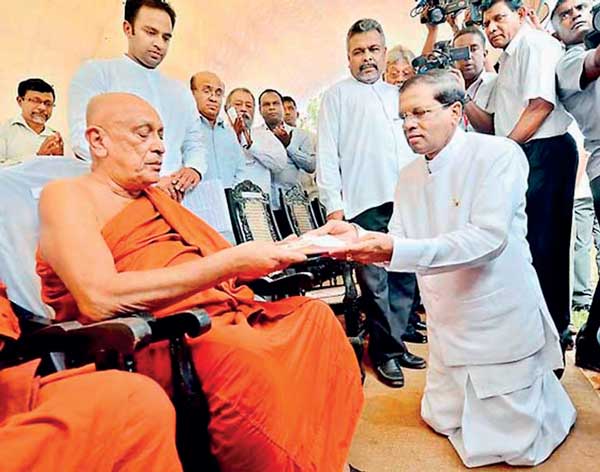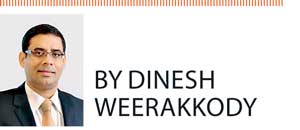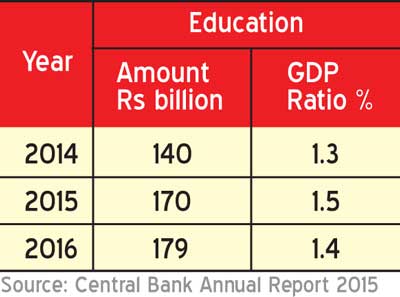19 Sep 2016 - {{hitsCtrl.values.hits}}

President handing over the first copy of his manifesto to the late Ven. Sobitha Thera
 Respected former Central Bank Deputy Governor W.A. Wijewardena reminded the government that the falling education and healthcare expenditure ratios should worry the Yahapalana government. See more at:
Respected former Central Bank Deputy Governor W.A. Wijewardena reminded the government that the falling education and healthcare expenditure ratios should worry the Yahapalana government. See more at:
http://www.ft.lk/article/565796/The-falling-education-and-healthcare-expenditure-ratios-should-worry-the-Yahapalana-Government#sthash.pI1x4cQh.dpuf. President Sirisena in his election manifesto presented to the public during the presidential election in 2015 promised to progressively increase the expenditure on education from 1.5 percent to 6 percent of gross domestic product (GDP) by 2020.
Commitment

In fact, the writer requested Prime Minister Ranil Wickremesinghe to include this commitment of progressively increasing the expenditure on education in the common opposition manifesto and subsequently in the United National Party (UNP) manifesto presented to the public in August 2015. The prime minister has many times over the last few months reassured the key stakeholders that he would progressively increase the spending on education. The prime minister appointed a committee in 2015, chaired by the writer, to consult all the key stakeholders and also study the global best practices and develop a road map to progressively increase the expenditure on education from 1.5 percent to 6 percent of GDP. (See chart: The current spending and percent)
The committee that included many key stakeholders noted that in general there was: inadequate infrastructure provision, deficit in teacher quality and quantity, irrelevance of curriculum, inadequacies in orienting education to changing technologies and economies, lack of management and co-ordination in the sector. Further, though much has been invested in the tertiary, vocational and professional (T, V & P) education over the past few years, the output had been mixed, with many students not completing their programmes.
Finally, there is a low enrolment rate in the higher education sector, where only 17 percent who qualify to enter are admitted, due the limited number of places available, compared to the 99 percent enrolment rate in the secondary school sector. This is due to a low investment in the higher education sector (only 0.33 percent of GDP), one of the lowest worldwide. The committee concluded that to get the best out of such increased expenditure, radical policy changes would be required.
Some of the key initiatives the committee suggested the government should address in the road map are:
nInsisting on quality assurance of higher education, primarily through international accreditation and overseas external examiners – the visits pertaining to which will need to be provided for.
Looking ahead
If the government is to deliver on its promise of progressively increasing the expenditure on education from 1.5 percent to 6 percent of GDP, the government would need to play a leadership role in the ongoing national dialogue over how to improve the results of our education, tertiary, vocational and professional education and higher education system for all students. This involves such activities as raising national and community awareness of the education challenges confronting the nation, disseminating the latest discoveries on what works in teaching and learning and helping all stakeholders to work out solutions to some of the difficult educational issues currently facing Sri Lanka.
Therefore, blindly pouring money into education without a clear strategy to achieve the 6 percent, will certainly sound and look foolish. Schools must strive to offer a path to the middle class, for children from hard-working families in every community, particularly those living in poverty. Yet, too many students lack access to education and support that make the journey to the middle class possible. The administration therefore must be committed to ensuring equity of opportunity for every child.
Improving higher education access and completion is an economic necessity and a moral imperative. Few good career options exist for those whose education ends at OL, since most jobs that pay a middle-class salary require a college degree. The university has long represented the surest route to the middle class. Therefore, increasing affordability and improving university access, quality and relevance must be a major focus of the 2016 Budget.
(Dinesh Weerakkody is an HR thought leader)
10 Jan 2025 59 minute ago
10 Jan 2025 2 hours ago
10 Jan 2025 2 hours ago
10 Jan 2025 3 hours ago
10 Jan 2025 3 hours ago